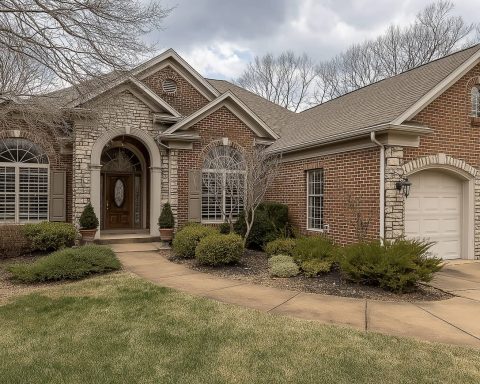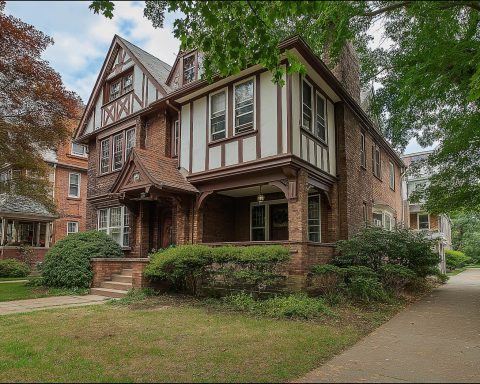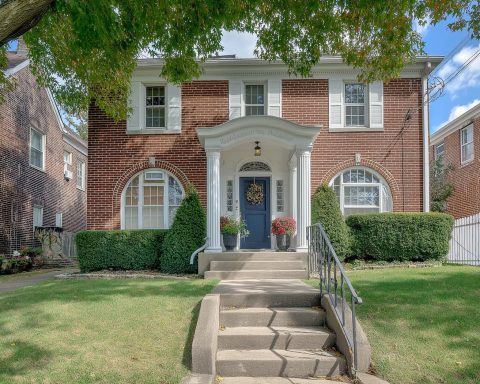- North America: Fed flags U.S. housing slump as a downside risk, with inventory rising and prices softening moneywise.com. Meanwhile, Canada launches a major homebuilding initiative to tackle its housing shortage einpresswire.com.
- Europe: UK home prices see broad declines – the widest in 18 months – amid weak demand reuters.com, prompting surveyors to predict further drops reuters.com. The ECB held rates at 2%, citing the economy is “in a good place” reuters.com as high borrowing costs cool real estate activity.
- Asia-Pacific: China’s property crisis rumbles on – Evergrande’s liquidators got bids for its $1.3 billion property services arm reuters.com reuters.com, and Beijing’s support steps still seek to stabilize the market. India’s housing market heats up, with prices now seen rising 6.3% in 2025 reuters.com despite affordability woes driving more renters reuters.com. Australia’s home prices rebound on rate cuts, but experts warn cheaper credit may further stretch affordability reuters.com reuters.com.
- Middle East: Gulf real estate booms – Abu Dhabi unveiled $758 billion worth of active projects tradearabia.com as new housing supply accelerates tradearabia.com. Qatar’s property sales jumped 18.5% in early September, reflecting dynamic demand across residential and mixed-use sectors arabnews.com arabnews.com.
- Latin America: Brazil’s housing market grapples with 15% interest rates, curbing affordability despite ~8% annual price gains (just ~2% after inflation) globalpropertyguide.com reuters.com. In contrast, Mexico’s tourism-fueled real estate sector stays resilient and is “closing 2025 on a strong note” amid sustained foreign investment mexlaw.com.
- Africa: Kenya leads global housing growth – prices surged 7.8% in the year to June, highest among key markets biznakenya.com, thanks to cash buyers insulating it from mortgage woes biznakenya.com. South Africa’s rate cuts (prime down to 10.75% after 4 drops) are spurring buyer activity, though a 2.3 million housing unit shortfall keeps demand high ooba.co.za ooba.co.za.
North America: Slumping U.S. Housing and New Canadian Housing Push
United States – Cooling Housing Market: The U.S. housing market showed fresh signs of cooling through late summer. Inventory has climbed and price growth flattened, leaving the market “slackening rather than roaring back,” according to the National Association of Realtors data moneywise.com. The Federal Reserve has taken notice: participants in its July meeting warned that a “more substantial deterioration in the housing market” poses a downside risk to employment moneywise.com. High mortgage rates – hovering around 6.6% for 30-year loans, the lowest in 10 months but still elevated realestatenews.com – have kept many buyers on the sidelines. “Markets with more inventory and room for negotiation could see more buyers take advantage of slightly lower rates,” observed Bright MLS economist Lisa Sturtevant, “but the downtick in rates may not ease the affordability hurdle for [first-time] buyers” realestatenews.com. Many existing owners remain “locked in” to ultra-low pandemic mortgages, limiting housing supply and trapping would-be move-up buyers moneywise.com. In short, affordability challenges and mortgage-rate lock-in effects continue to blunt U.S. housing demand despite a modest rate retreat.
U.S. Commercial Real Estate: On the commercial side, there are early glimmers of a rebound. Several top real estate firms (CBRE, JLL, Cushman & Wakefield, Colliers, and Newmark) reported robust second-quarter results and collectively raised their 2025 outlooks – the first such synchronized upgrade since 2020 credaily.com. Leasing activity is leading the recovery, especially for high-end offices. Demand for prime “trophy” office space has been so strong that it’s “spilling into well-located second-tier buildings,” driven by big employers’ return-to-office mandates credaily.com. Still, headwinds remain: financing is costly and economic growth is slowing, so analysts caution that a full commercial real estate rebound will be gradual. For now, however, the fall uptick in leasing and the willingness of buyers and sellers to make concessions are encouraging signs of stabilization in U.S. commercial property markets credaily.com.
Canada – Major Housing Construction Initiative: North of the border, Canada is taking bold action to address its housing supply crunch. On September 14, the Prime Minister was set to announce a new initiative to “scale up housing construction” across Canada einpresswire.com. The plan – to be unveiled at a modular housing site with the federal Housing Minister – comes amid surging rents and home prices in Canada’s major cities. With population growth outpacing homebuilding in recent years, the federal government aims to spur development of new homes (including affordable housing) by cutting red tape and funding infrastructure. The announcement underscores how urgent Canada’s housing affordability crisis has become. It follows recent moves like easing GST (sales tax) on new rental projects and incentives for municipalities that expedite building permits. Market reaction has been positive: developers and economists have long argued that boosting supply is key to taming Canada’s housing costs. While details are still emerging, the initiative is expected to provide funding and policy support to get more homes built quickly – a timely intervention as high borrowing costs had slowed construction. With Canada’s central bank holding interest rates steady, this housing push could help relieve pressure in overheated markets like Toronto and Vancouver if it succeeds in adding significant new inventory.
Europe: Weak Housing Sentiment and Steady Rates Amid Uncertainty
United Kingdom – Prices Falling and Buyer Caution: Europe’s housing markets present a mixed picture, but signs of strain are evident in the UK. British house prices have begun to fall broadly after years of growth. In August, prices showed their most widespread declines in a year and a half, according to the Royal Institution of Chartered Surveyors (RICS) reuters.com. The RICS house price balance dropped to –19 (down from –13 in July), indicating many more surveyors seeing price falls than rises. New buyer inquiries have dwindled to recessionary lows as high inflation, economic uncertainty, and rising mortgage costs cool demand reuters.com. “With buyer demand easing and agreed sales in decline, the housing market is clearly feeling the effects of ongoing uncertainty,” said RICS economist Tarrant Parsons, noting concerns about the economic outlook and interest rates are “weighing on sentiment at this time” reuters.com. Indeed, UK inflation is still running about 6% – above target – and buyers face mortgage rates around 5–6%, which has sharply reduced affordability. Surveyors expect further price softening near-term. Notably, the pullback comes even as some mortgage lenders (Halifax, Nationwide) reported flat or slightly rising prices over the summer reuters.com, suggesting a late-year downshift is underway. In the rental market, the story is the opposite: tenant demand far outstrips supply, and landlord listings are dwindling. RICS found landlord instructions fell at the fastest pace since early 2020, pushing up rents; a net 27% of surveyors expect rents to keep rising in coming months reuters.com. This divergence underscores the UK’s housing pain point – insufficient supply – which is now translating into falling sale prices but surging rents.
Continental Europe – High Rates Bite, but ECB Holds Steady: Across the Eurozone and beyond, high borrowing costs have dampened real estate activity in 2025. Commercial investment volumes are down and residential transactions have slowed in many countries compared to the frenzy of 2021–2022. However, the European Central Bank this week opted to hold interest rates unchanged – keeping the deposit rate at 2% – after a series of cuts earlier in the year. The ECB’s Governing Council on Sept 11 left rates intact and sounded an unexpectedly upbeat tone. President Christine Lagarde stated, “We continue to be in a good place,” with inflation near desired levels and the Eurozone economy proving resilient reuters.com. This decision to pause easing suggests European policymakers are cautiously watching how prior rate cuts filter through. The central bank had halved its key rate from 4% to 2% by June and is now assessing if further stimulus is needed. For real estate, the stable rate outlook at least provides some certainty for financing costs. Markets had largely expected no change, but the ECB’s optimism tempered hopes of any imminent extra cuts reuters.com reuters.com. In Germany, for example, the housing market is showing tentative signs of stabilization after a mild correction – nominal home prices rose ~3.8% year-on-year in Q1 2025 after declines last year reuters.com, partly thanks to improved sentiment as rate hikes paused. Nonetheless, activity remains muted, and in some European cities like Stockholm and Amsterdam, prices are still below their 2022 peaks as buyers adjust to higher mortgage costs.
European Commercial & Policy Developments: In Europe’s commercial property sector, higher interest rates have caused values of offices and retail properties to soften, and lending is tight. But there are pockets of opportunity: sellers are beginning to bring prime assets to market, anticipating that yield-hungry investors will return. This week saw prime London offices, Irish logistics facilities, and German offices put up for sale, according to industry reports, as owners test investor appetite realassets.ipe.com. European regulators are also attentive – for instance, Germany is considering easing zoning rules to spur housing construction, and Ireland has extended tax breaks for landlords to stem an exodus from the rental market (amid record-high rents). Meanwhile, the EU is finalizing its planned Green Building Directive, which could require costly energy-efficiency upgrades to older commercial buildings by 2027. All told, Europe’s real estate mood is one of cautious adjustment: demand is there – especially for quality assets and rentals – but uncertainty over interest rates and policy continues to swirl, keeping both buyers and sellers somewhat guarded as 2025 nears its close.
Asia-Pacific: China’s Ongoing Property Crunch, India & Australia on the Rise
China – Debt Crisis and Asset Sales: China’s real estate market remains in the throes of a protracted slump, even as authorities roll out support measures. The country’s once-mighty developers are struggling under heavy debt. This week brought a small ray of hope for beleaguered China Evergrande Group, which is navigating bankruptcy restructuring. Liquidators for Evergrande received initial bids for the developer’s majority stake (51%) in Evergrande Property Services Group, its property management arm reuters.com reuters.com. The unit, valued around HK$10 billion (~$1.3 billion) before the news, saw its Hong Kong–listed shares surge as much as 40% on Friday amid speculation that state-backed firms might acquire the stake reuters.com. Bloomberg reported interest from subsidiaries of state giants China Overseas and China Resources, though at least one firm denied bidding reuters.com. “Under a liquidator’s auction, nothing firm will occur until at least November,” noted analyst David Blennerhassett, meaning any sale – if it materializes – will take time reuters.com. Evergrande’s predicament is emblematic of China’s broader property woes. Property sales, investment, and new construction have all fallen in 2025 as the government’s deleveraging campaign exposed weak balance sheets across the sector reuters.com. Dozens of developers like Evergrande and Country Garden have defaulted on offshore bonds. Despite policy support – from lower mortgage down payments to local governments buying unsold homes – the housing market has yet to find a bottom reuters.com. A Reuters poll this quarter showed new home prices are expected to decline 3.8% in 2025, not as steep as earlier feared, but extending the downturn into a fifth year reuters.com. Analysts say Beijing may need to consider more direct intervention to break the negative spiral reuters.com. For now, Chinese homebuyers remain skittish, especially in smaller cities with oversupply, and housing sentiment is at multi-year lows. The government’s delicate task is to stimulate demand without triggering another debt binge – making any progress, like potential asset disposals or mergers, welcome news in an otherwise fraught market.
India – Home Prices Surge Amid Inequality: India’s housing market is charting an opposite course – demand is robust and prices are climbing, though not everyone is benefiting. A new Reuters poll of property experts forecasts Indian home prices will rise 6.3% in 2025 and accelerate to 7.0% in 2026 reuters.com, well above the ~4% gain seen in 2024. This upbeat outlook is fueled by solid economic growth (India’s GDP is expanding ~6–7%) and a surge of affluent buyers. However, it comes with a downside: the supply of affordable housing is shrinking, leaving millions of lower-income Indians stuck renting in pricey cities. “The current problem is strong macro numbers have not benefited the population at the lower side of the pyramid… Their disposable incomes have stagnated,” observed Ajay Sharma, Managing Director of valuation services at Colliers India reuters.com. This inequality in income growth means many urban migrants can’t afford to buy even as luxury housing booms. Indeed, India faces an affordable housing deficit of ~10 million homes, a gap projected to triple by 2030 reuters.com. With homeownership out of reach, renting has surged: urban rents are expected to jump 5%–8% over the next year, outpacing general inflation reuters.com. “As affordability declines, more people are renting – and as more people rent, rentals have gone up,” Sharma noted of the vicious cycle reuters.com. Still, India’s overall real estate mood is positive. Developers are launching new projects and foreign investors have shown interest (e.g. in commercial and tech park assets). The hope is that rising middle-class incomes and government incentives (like subsidy schemes for first-time buyers) will broaden homeownership. For now, India’s property market is bifurcated: a booming high-end segment and a struggling affordable segment – reflecting the broader tale of two Indias.
Australia – Rebound in Home Values: Australia’s housing market is rebounding faster than expected thanks to a turn in monetary policy. After a modest correction in 2022–23, home prices are climbing again in 2025. The Reserve Bank of Australia has cut interest rates by a cumulative 0.75 percentage points since February, bringing its cash rate down, which in turn has started to reduce mortgage rates reuters.com reuters.com. Cheaper financing is re-energizing buyer demand. A Reuters housing poll now predicts Australian home values will rise about 5% this year and another 5–6% in 2026 reuters.com reuters.com – a notable upwards revision from earlier forecasts of ~4%. Major cities like Sydney and Brisbane are leading the gains, with analysts noting a clear uptick in auction clearance rates and buyer inquiries since the RBA’s rate cuts. “We’re expecting the lift in house prices to continue – it’s really been picking up since the RBA delivered its second rate cut,” said Johnathan McMenamin of Barrenjoey, adding that each additional cut boosts household buying power reuters.com. However, Australia’s perennial issue of affordability has not disappeared. The national median house price is nearly 8 times the average income reuters.com, among the highest ratios in the world. Supply remains tight, as construction has lagged population growth. Some experts caution that the very relief meant to help buyers – lower rates – could backfire by stoking more price increases. “The recent interest rate cut is welcome news for homeowners and investors, but… in markets with chronic undersupply, the effect can actually push prices further out of reach,” warned Michael Yardney, CEO of Metropole, noting that unless homebuilding accelerates, cheaper credit will mainly “fuel demand” and price gains reuters.com. In the short term, Aussie buyers seem to be taking the plunge: home sales volumes are trending up and investor activity has ticked higher in anticipation of continued rate relief. The rental market, meanwhile, remains very tight – vacancy rates in Sydney and Melbourne are near record lows – which is attracting more investors into the fray. Overall, Australia enters the end of 2025 with housing momentum on the upswing again, balancing on that knife’s edge between renewed growth and bubble risk that policymakers know all too well.
Elsewhere in Asia-Pacific: Other regional markets show a mix of trends. Japan is seeing a wave of inbound real estate investment – overseas investors poured over $10 billion into Japanese property in H1 2025 (a 45% YoY jump) as a weak yen and Japan’s ultra-low rates make its assets attractive ainvest.com. Tokyo’s prime office occupancy has improved, and nationwide land values rose ~2.7% this year, the fastest since 2010. Southeast Asia remains generally robust: for example, Singapore’s commercial property is drawing capital from funds rotating out of China, and Vietnam and Indonesia are benefiting from manufacturing inflows (boosting demand for industrial/logistics real estate). However, New Zealand’s housing market is still soft – prices in Auckland are down ~5% year-on-year – as the Reserve Bank holds its policy rate at a restrictive level to tame inflation. All told, Asia-Pacific real estate is highly heterogeneous: markets like India, Australia, and parts of SE Asia are on the upswing, while China and a few others continue to work through significant corrections and oversupply issues.
Middle East: Gulf Property Booms, Investment Flows and Housing Initiatives
Abu Dhabi, UAE – $758 Billion Development Boom: The Middle East’s property markets are largely buoyant, underpinned by strong economic conditions and government initiatives. In Abu Dhabi (UAE’s capital), authorities highlighted the massive scale of projects underway as the city hosted the International Real Estate & Investment Show (IREIS 2025) from Sept 12–14. A new report revealed that “the total value of active development projects in Abu Dhabi exceeds $758.79 billion” tradearabia.com. This staggering figure – spanning urban mega-developments, new residential communities, infrastructure, and industrial expansions – underscores the emirate’s construction boom. A large chunk ($221.5 billion) is in urban building works alone tradearabia.com. The pipeline is only growing: around 2,400 housing units have been delivered in Abu Dhabi City so far in 2025, and 10,400 more homes are slated for completion by year-end, with another 11,000 in 2026 tradearabia.com. This acceleration in supply, noted by consultants Cavendish Maxwell, comes as the UAE tries to keep up with population growth and record demand from expatriates and investors. Government-led initiatives – such as allowing 100% foreign ownership in designated zones and expanding long-term visas – have fueled real estate investment. Developers like Aldar and Eagle Hills are launching new communities (e.g. waterfront developments on Yas and Saadiyat Islands) that are seeing high uptake. The Abu Dhabi market sentiment is very positive: sales transaction volumes in 2025 are on track to beat last year’s, and prices in prime areas have risen modestly. With oil revenues bolstering government spending and tourism rebounding, the Gulf’s property prospects remain strong. As Amer Al Ahbabi, a senior Emirati official, said at IREIS’s opening, Abu Dhabi’s real estate sector is a “key economic powerhouse” – and the sheer scale of ongoing projects confirms it.
Qatar – Surge in Property Transactions: In nearby Qatar, the real estate market is also demonstrating dynamism. Official data for early September showed a notable surge in property sales. In just the week from Aug 31 to Sept 4, Qatar logged QR 394.35 million ($108 million) worth of real estate transactions arabnews.com. That’s an 18.5% jump from the previous week’s volume arabnews.com. The deals spanned a mix of asset types – vacant land, houses, residential buildings, and commercial-residential complexes – indicating broad-based activity arabnews.com. Most transactions were concentrated in Doha and the Al-Rayyan municipality (which together accounted for over 60% of traded value), with notable deals also in Al-Wakra and emerging areas like Lusail arabnews.com. The Ministry of Justice’s weekly bulletin described “continuing market dynamism, driven by both end-users and investors” across residential and mixed-use properties arabnews.com. Indeed, Qatar’s property sector has been on an upswing since the successful FIFA World Cup in 2022, which boosted infrastructure and global interest. Rents in Doha have climbed over the past year due to an influx of expatriates, and developers are moving forward with new projects in planned cities like Lusail and The Pearl. Analysts expect Qatar’s recent decision to loosen foreign ownership caps in real estate to further stimulate investment. The early-September bump in sales suggests confidence ahead of an anticipated autumn selling season. Additionally, Qatar’s robust GDP growth (~3% in 2025) and gas-fueled wealth are providing locals with capital to invest in property, keeping the market lively despite higher interest rates.
Saudi Arabia & GCC – Market Support and New Ventures: In the region’s largest economy, Saudi Arabia, the real estate sector remains a central focus of Vision 2030 diversification efforts. A government report this week outlined measures to stabilize the housing market – including expanding affordable home financing and accelerating construction technologies – to help meet Saudi’s goal of 70% homeownership by 203080.241.146.114. The kingdom’s sovereign Public Investment Fund (PIF) continues to pour money into giga-projects like NEOM and Diriyah Gate, which are progressing rapidly. Market observers note that housing prices in Riyadh have risen in 2025 due to population growth and limited supply, though new mega-developments on city outskirts aim to add inventory. Across the Gulf, other news included: Dubai’s ENBD REIT reporting record-high occupancy and net asset growth, thanks to Dubai’s booming property cycle travelandtourworld.com; and Oman and Bahrain launching new urban masterplans to attract foreign investors. Even beyond the Gulf, Middle Eastern investment is active – e.g. UAE’s Aldar Properties just made its first foray into Pakistan’s real estate market arabnews.com, and Abu Dhabi’s sovereign funds are reportedly eying assets in Europe and Asia as they diversify. Overall, the Middle East’s real estate markets in 2025 are characterized by strong government support, high liquidity, and ambitious development agendas, keeping the sector upbeat even as global markets cool.
Latin America: High Rates Temper Markets, but Tourism and Foreign Cash Drive Growth
Brazil – High Interest Rates Weigh on Housing: Latin America’s largest economy, Brazil, is navigating a challenging environment for real estate due to extremely high interest rates. The Central Bank’s benchmark Selic rate stands at 15%, a near 20-year high aimed at quelling inflation reuters.com. These borrowing costs – the legacy of a 450 bps hiking cycle in 2024 – have pushed mortgage rates into the mid-teens, putting home loans out of reach for many Brazilians. As a result, housing market activity has cooled compared to last year’s post-pandemic boom. Yet, prices continue to rise in nominal terms. In April 2025, Brazil’s nationwide house price index was up 7.97% year-on-year globalpropertyguide.com. Adjusted for inflation (which is ~5–6%), that’s about a 2.3% real increase – modest growth but notably one of the stronger real estate performances among major economies this year. The resilience is partly due to robust demand in certain cities. São Paulo, for instance, saw prices jump 6.1% YoY (nominal) through April, its sharpest climb in a decade globalpropertyguide.com. Even Rio de Janeiro – long a laggard – posted a 4.6% YoY price gain (though slightly negative in real terms) globalpropertyguide.com. Still, the high-rate environment is biting: home sales in volume terms have leveled off after surging in recent years, and developers face higher financing costs for new projects. Brazil’s central bank signaled in August that it intends to keep rates “very prolonged” at current levels until inflation is decisively curbed reuters.com. This could mean muted real estate growth ahead. On a positive note, housing credit has largely avoided the kind of bubbles seen elsewhere – less than 20% of Brazilian homes are financed by mortgages – and delinquency rates remain low. Market players are eagerly awaiting rate cuts (perhaps in 2026) to reignite the sector. In the meantime, cash buyers and investors are focusing on niches like São Paulo’s mid-income apartments and the booming logistics/warehouse segment (where e-commerce growth drives demand). Overall, Brazil’s property market in 2025 is steady but restrained – lots of latent demand, but high interest costs acting as a governor on activity.
Mexico – Tourism-Fueled Real Estate Resilience: In contrast to Brazil, Mexico’s real estate sector is benefiting from lower interest rates and strong external demand. Mexico’s central bank held rates steady around 11.25% this year (after peaking earlier), and inflation has been on a downward trend. This stable macro backdrop, combined with Mexico’s proximity to the U.S., has made it a magnet for investors and second-home buyers. As a result, Mexico’s property market is closing 2025 on a strong note, with resilience and sustained growth despite global challenges mexlaw.com. A key driver is tourism. Locations like Cancún, Playa del Carmen, Puerto Vallarta, and Los Cabos are seeing vigorous real estate activity – luxury beachfront condos, villas, and resort-adjacent residences are in high demand from North American and European buyers. International visitor numbers are on track to hit record highs, fueling construction of hotels and short-term rental properties. At the same time, Mexico’s manufacturing boom (thanks to “nearshoring” of U.S. supply chains) is drawing foreign executives and expats, boosting housing markets in Mexico City, Monterrey, and other business hubs. According to industry analyses, foreign investment in Mexican real estate is rising, drawn by relatively affordable prices and growth prospects. “Mexico often delivers higher returns than the U.S. or Canada,” noted one report, pointing to the combination of a stable peso and competitive operating costs mexlaw.com. The government is also supporting the sector; it recently extended a VAT exemption for residential sales and is investing in infrastructure (new airports, trains) that open up property hotspots. Challenges remain – housing affordability for local buyers is an issue, especially as expat demand pushes up prices in Mexico’s prettiest towns. But overall, Mexico’s market outlook is upbeat: analysts predict home price gains of 5–6% this year, and commercial real estate (like industrial parks along the U.S. border) is booming due to nearshoring. Barring an external shock, Mexico appears set to end the year as one of Latin America’s real estate success stories, leveraging its unique mix of tourism appeal and manufacturing growth.
Other LatAm Markets: Across Latin America, real estate trends vary. In Chile, the housing market is stabilizing after a mild correction, as the central bank aggressively cut rates (by 175 bps so far in 2025) to support growth. Santiago apartment prices are roughly flat year-on-year, and lower mortgage rates are expected to spur a pickup in 2026. Colombia and Peru are also cutting rates, which should ease pressure on their property markets, though high construction costs remain a headwind. On the other hand, Argentina continues to face a housing affordability crisis amid triple-digit inflation and a weak peso – real estate transactions there have plunged because most deals are done in cash USD, which are scarce. Interestingly, high-net-worth Latin Americans are increasingly turning to overseas property: Miami and Dubai real estate agencies report a surge of buyers from Latin America in 2025, seeking stable investments amid local uncertainties. Indeed, South Florida saw $367 million of home purchases by Latin American buyers in the past year discoversouthflorida.com, making them a dominant force in that market. This capital flight trend underscores how local real estate slowdowns in LatAm can translate into booms elsewhere.
Africa: Kenya’s Housing Outperformance and South Africa’s Buyer’s Market
Kenya – Top Global Housing Returns: In Africa, Kenya has emerged as a standout performer in real estate. A special housing market report released on Sept 9 highlighted that Kenyan homes are delivering investment returns unrivaled globally biznakenya.com. Since 2000, Nairobi’s residential property prices have skyrocketed 425%, far surpassing gains in the U.S. (201%) or Europe biznakenya.com. And 2025 is extending that lead: Kenya saw a 7.8% rise in property prices in the year to June 2025, the highest appreciation among the nine major markets analyzed (the next closest was Australia at 4.7%) biznakenya.com. The report, by research firm HassConsult, attributes Kenya’s extraordinary housing resilience to its unique financing dynamics. “Homes in Kenya are fully paid [in cash], which makes the market super-resilient,” explained Sakina Hassanali, HassConsult’s Co-CEO biznakenya.com. Fewer than 2% of Kenyan homes are mortgage-financed (versus 60–90% in Western markets) biznakenya.com. This means Kenyan homeowners are rarely burdened by large debts or forced sales, even during economic dips – a stark contrast to markets that suffered foreclosures when rates rose. Additionally, Kenya’s growing middle and upper class has kept housing demand robust. High earners in sectors like education, healthcare, and tech are fueling upscale home purchases, while the country’s expanding population (and rapid urbanization in Nairobi and secondary cities) underpins fundamental demand. Notably, rental yields in Kenya also remain attractive at ~5.5% on average, higher than many developed markets biznakenya.com. When combined with capital gains, total returns for property investors in Kenya were over 13% in the past year biznakenya.com – truly impressive. Even higher returns accrue to those investing in off-plan developments: early buyers in new projects enjoy discounts and have seen ROI around 18% in 2025 biznakenya.com. Of course, Kenya’s market is not without challenges. There are pockets of oversupply in high-end apartments, and developer financing can be shaky (some projects stall due to funding issues). But overall, Kenya’s formula of low leverage, steady domestic demand, and a culture of real estate as a preferred investment has made it a star in 2025. As other markets grapple with interest rate shocks or aging populations, Kenya’s housing sector is “pulling ahead” and is expected to continue on an upward trajectory barring major shocks.
South Africa – Rate Cuts Spark Life in Property Market: South Africa, the continent’s most advanced economy, is seeing its property market tilt back in favor of buyers after a tough few years. The South African Reserve Bank embarked on a rate-cutting cycle from late 2024 through 2025, finally providing relief from prior steep hikes. There have been four consecutive 25 bps rate cuts since September 2024, bringing the prime lending rate down from 11.75% to 10.75% as of May 2025 ooba.co.za. Another quarter-point trim to 10.50% is anticipated by year-end ooba.co.za. These are the most favorable financing conditions South Africa has seen in years. As a result, banks are competing for home loan customers and approval rates for mortgages have improved. Real estate agents report an uptick in first-time buyer activity: in recent months, nearly 47% of home loan applications have been from first-time buyers, a very high share historically ooba.co.za. The rationale is clear – after a decade of rising rates, South Africans are seizing the moment of cheaper credit. Demand remains especially strong in the mid-market segment (homes for young families) and in attractive “semigration” destinations (coastal areas like Cape Town where many are relocating for lifestyle). The housing supply side, however, is constrained. South Africa still has an estimated housing shortage of 2.3 million units ooba.co.za, particularly in affordable housing. New construction has been sluggish, which, combined with renewed demand, could start pushing prices up again. So far in 2025, national house price growth has been modest (around 3–4% YoY), but analysts expect an acceleration in 2026 if rates continue to fall. In the rental market, demand is high in urban centers as some potential buyers choose to rent and wait for further rate cuts. Rental yields in Johannesburg and Pretoria are in the 8–10% range for sectional-title properties, reflecting relatively low property values versus rents. Notably, commercial real estate in South Africa offers even higher cap rates (often above 11% ooba.co.za ooba.co.za), which is drawing interest from investors now that financing costs are easing. Overall, South Africa’s property market in 2025 can be described as one moving from stagnation toward recovery. “We’re experiencing the most significant rate-cutting cycle in years,” one mortgage lender noted, “creating unprecedented opportunities for property buyers” ooba.co.za ooba.co.za. If inflation stays low (it’s currently ~2.8%, below the SARB’s target band ooba.co.za) and the economy avoids major shocks, 2025 could mark the beginning of a sustained housing uptick in South Africa.
Sub-Saharan Africa – Mixed Outlook: Elsewhere on the continent, real estate trends vary widely. Nigeria, Africa’s most populous nation, is witnessing a property boom in its commercial capital Lagos – land and luxury apartments on Lagos Island have appreciated sharply in 2025, driven by diaspora buyers and investors hedging against naira inflation. But high construction costs (partly due to currency devaluation after fuel subsidy removal) have squeezed developers, slowing new supply. Ghana is recovering from a 2022 financial crisis; housing construction is gradually picking up as inflation there falls, and Accra’s office market has stabilized with rents holding firm in USD terms. In North Africa, Egypt’s real estate remains a preferred inflation hedge for locals amid the Egyptian pound’s drop – property prices in Cairo are up over 30% this year in local currency, though roughly flat in USD. Egypt is also opening new phases of its New Administrative Capital, a massive development aimed to alleviate Cairo’s congestion. Finally, African capital flows into real estate are rising: a recent report noted that a group of prominent African business families have allocated $1.4 billion to real estate and impact investments in the region sbs.ox.ac.uk, signaling growing domestic investment capacity. This includes projects like affordable housing funds and green building ventures. Such efforts are crucial to meet Africa’s urbanization challenge – the continent’s cities are swelling, and housing supply must catch up. While hurdles from financing to infrastructure persist, the long-term outlook for African real estate is one of significant growth potential, as evidenced by success stories like Kenya and the newfound buyer’s market in South Africa.
Sources:
- MoneyWise (Yahoo/SmartNews syndication) – Fed raises alarm over housing market downturn moneywise.com moneywise.com
- EIN Presswire (Prime Minister of Canada release) – PM to announce housing construction initiative einpresswire.com
- Real Estate News – Mortgage rates hit 10-month low; buyer trends realestatenews.com realestatenews.com
- CRE Daily – Q2 commercial real estate recovery signals credaily.com credaily.com
- Reuters – UK housing market slows, RICS survey reuters.com reuters.com; ECB holds rates at 2% reuters.com reuters.com
- Reuters – Evergrande seeks bids for property services arm reuters.com reuters.com; China property poll (Q3 2025) reuters.com reuters.com
- Reuters – India home prices to soar – Reuters poll reuters.com reuters.com
- Reuters – Australia home prices to rise on rate cuts – poll reuters.com reuters.com
- TradeArabia / Gulf Construction – Abu Dhabi projects worth $758.7B (IREIS 2025) tradearabia.com tradearabia.com
- Arab News – Qatar real estate sales early Sept arabnews.com arabnews.com
- Reuters – Brazil central bank holds rate at 15% reuters.com; GlobalPropertyGuide – Brazil house price index April 2025 globalpropertyguide.com
- MexLaw – Mexico real estate 2025 driven by tourism mexlaw.com
- Bizna Kenya – Kenya property prices up 7.8%, top global returns biznakenya.com biznakenya.com
- Ooba (SA Mortgage) – South Africa rate cuts and housing outlook ooba.co.za ooba.co.za












